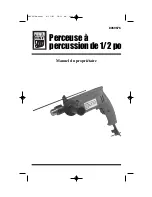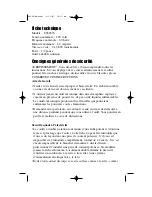
• Don’t expose power tools to rain or wet conditions. Water entering a
power tool will increase the risk of electric shock.
• Do not abuse the cord. Never use the cord to carry a tool or pull a plug
from the outlet. Keep cord away from heat, oil, sharp edges and moving
parts. Replace damaged cords immediately. Damaged cords increase the
risk of electric shock.
• When operating a power tool outside, use an outdoor extension cord
marked “W-A” or “W”. These cords are rated for outdoor use and
reduce the risk of electric shock.
Personal Safety
• Stay alert, watch what you are doing and use common sense when
operating a power tool. Do not use tools while tired or under the
influence of alcohol or medication. A moment of inattention while
operating power tools may result in serious personal injury.
• Dress properly. Do not wear loose clothing or jewellery. Tie back long
hair. Keep your hair, clothing, and gloves away from moving parts.
Loose clothes, jewellery, or long hair can be caught in moving parts.
• Avoid accidental starting. Be sure switch is off before plugging in.
Carrying tools with a finger on the switch or plugging in tools with the
switch on invites accidents.
• Remove adjusting keys or switches before turning the tool on. A wrench
or a key that is left attached to a rotating part of the tool may cause
personal injury.
• Do not overreach. Keep proper footing and balance at all times. Proper
footing and balance enables better control of the tool in unexpected
situations.
• Use safety equipment. Always wear eye protection. Dust mask, non-skid
safety shoes, hard hat, or hearing protection may be used for appropriate
conditions.
Tool Use and Care
• Use clamps or other practical way to secure and support the workplace
to a stable platform. Holding the work by hand or against your body is
unstable and may lead to loss of control.
• Do not force tool. Use the correct tool for your application. The correct
8069676manual 4/11/05 10:33 AM Page 3
































